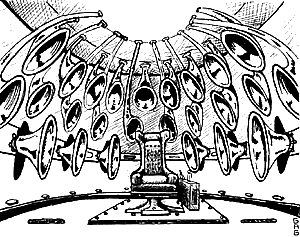The complex is deliberately presented in a rough outline. The proposed concept requires further research into it's direction and meaning (the industrial environment strictly speaking generates a culture), it's form (artistic societies, music, theatre, drama, etc.), it's purpose (aim) (a venture incorporating research and cultural output with an open economic nature).
One must envisage the Complex as a vast entity whose outlines are only emerging, conceived in accordance with a logic at odds with conventional thinking (antagonism between the world of industry and art)
As the third millennium is dawning (shouldn't the Complex be made operational on the 1st of Jan 2001 at 0h U.T. ?) the industrial world is becoming aesthetic and human. This leads us to the running of the Complex : it produces various artistic materials developed according to a methodology in line with industrial influences. This is in it's turn the thread through the whole production. The "Raw materials" (music, dance, theatre, etc.) traditional and contemporary, experimental and avant-garde will be drawn from the gigantic minds of man's creative genius.

| Musical extract
in accompaniment of the visit (en RealAudio) |
|||
|
Henrik Gorecki Symphony N° 3 |
|||
The complex consists of auditoriums, a large space for concerts and objects (set out as a maze). The complex units could assemble a collection of ancient or unusual musical instruments, a bank of industrial sounds.
In line with the above principle, the complex integrates the peripheral developments needed for the cohesion of it's production. Thus each of it's components infer the supply of specialised skills :
- Industrial architecture
- Sound technology, electro-acoustic
- Philharmonic and musical arts - theatre production
- Plastic arts - theatre production
- Mechanical engineering and industrial techniques
- Financial management, development, communication
- A welcome for the public
The peripheral implementation of the complex production goes three ways
- To capture the widest audience possible ( i.e. : the implications in teaching new musical fields lead to an opening towards schools.
- To further the settling up of research and musical and artistic departments in house, the Complex must emerge as the place for exchange and activity for the largest possible number of artists
- Socially, the building, the setting up, fitting out and management of the complex must generate employment.